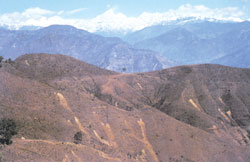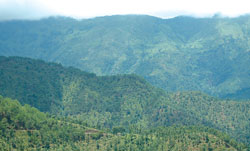|
|
| The hill around Chautara in 1978 |
Manik Lal Shrestha remembers 30 years ago when the mountains that surround this scenic capital of Sindhupalchok district were barren.
But over the years he has watched the dry brown hills turn into lush green slopes.
In fact, across Nepal's midhills, the spread of community forestry has dramatically returned forests to once-denuded hillsides. But few know that the seeds of that success were planted here in Sindhupalchok and Kabhre in 1976 by an Australian forestry project that pioneered the concept of letting villagers manage the commons.
From his porch, Manik Lal can survey almost all 56 hectares of the Chaapal Danda forest that his community manages on a nearby slope, one of hundreds of such areas set up by local communities here in the past decades.
"Thirty years ago there was no forest, it was difficult to get wood but today there is no shortage," Manik Lal tells us. The success of his Chaapal Danda Community Forest Users Group has permitted farmers to buy extra livestock and communities to invest in infrastructure like roads and schools.
|
|
| And today |
In the 1970s and 1980s, the forestry project focused on land-use planning, establishing 100 community-run seedling nurseries for example. But by 2000 the project was renamed the Nepal Australia Community Resource Management and Livelihoods Project (NACRMLP), signalling a renewed focus on poverty reduction. The project was finally closed on 30 June.
"The project contributed to a fundamental paradigm shift for forestry academics around the world," Percy Stanley, AusAid's South Asia director told a function in Kathmandu last week to mark the project's end. "Locally appropriate adaptations for ensuring community involvement in natural resource management are now found in many countries of Africa, Central and South America."
 Chaapal Danda Community Forest guard Chok Bahadur Dulal and Secretary Manik Lal Shrestha with trees marked for thinning. |
In its last phase, the project worked closely with 20 community forest user groups in the two districts to develop Forest Operation Plans that emphasise good governance, business development and sustainable management of forests. Some of the groups started enterprises that make goods such as bio briquettes and sal leaf plates, which provide 230 jobs to locals.
So why shut down something that was working so well? Australian Ambassador Graeme Lade says it was the new priorities for Australian foreign aid. "Also, a project at some stage has to finish," he added, "you have to give the community forest user groups the responsibility to stand on their own two feet."
Australia will provide US 482,000 to the UNDP's Micro-enterprise Development Program from 2006-2008 to help forest communities market their products.
Now that the trees are mature, communities are grappling with new problems of forest management. The average forest contains up to 700 trees per hectare but Poudyal says they should be thinned to about 300 trees a hectare, providing room for those remaining to grow larger and more valuable.
The Ministry is now examining thinning guidelines developed by the project in the last year. The thinned trees could be sold now and would provide a lot of income for the local communities, says DFO Arun S Poudyal. But villagers are reluctant to let their long-tended forests go, fearing that if they let contractors in, they'll cut everything down.
NACRMLP estimates that selling timber from community forests could earn the villages Rs 1 billion a year for the next 20 years. Said Stanley in his farewell speech: "Rs 1 billion a year in the hands of local groups can finance the building and management of a lot of rural infrastructure."




